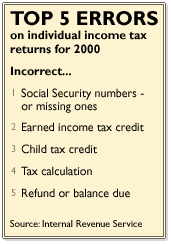
NEW YORK (CNN/Money) - Another year, another excuse to procrastinate.
The April 15 deadline is just three weeks away and yet millions of taxpayers are still trying to avoid the 1040 forms on their dining room tables. Those who wait to file at the last minute, however, not only cause themselves undue anxiety, but are also more likely to rush through their returns -- making them more susceptible to overlooked deductions and common mistakes that could land them in hot water with the IRS.
In the best-case scenario, your refund or payment could take longer to process. In the worst, you could get hit with an audit.
The IRS estimates that 15 percent to 20 percent of the 91 million paper returns filed last year contained a detectable error. Electronic returns are much cleaner: Less than 1 percent of electronic returns come in with errors since the tax preparation software flags filers of any mathematical errors or missing information.
So before you drop that return in the mail, follow our checklist and make sure you haven't made one of the mistakes below.
Ten tax commandments
1.) Sign and date your returns
"Failure to sign the return is a big one," said David R. Bergmann, an enrolled agent and certified financial planner in Marina Del Rey, Calif. Yes, people do this all the time -- put your John Hancock on that baby before you pop it in an envelope. And don't forget to date it either.
2.) Double check your math

Save it for restaurant tips: Now is not the time to pride yourself on the ability to crunch numbers in your head. Always double check your tax numbers with a calculator -- addition and subtraction errors are rampant. Errors in calculating the child or dependent-care tax credit and the earned-income credit were the two most common computation errors last year, according to the IRS.
3.) Know your own name
If you got married and are filing together for the first time, make sure the name you put on your return matches the one on your Social Security card. "The IRS will hold back a part of a refund if the two names don't match," said Frank Degen, an enrolled agent in Setauket, N.Y. Same goes for women who got divorced. If you changed back to your maiden name, make sure your Social Security card reflects that.
4.) Choose the right filing status
It seems simple to decide whether you're single, married or a head of household. But checking only one status or an incorrect filing status is a common problem, according to the folks at the IRS. More than 100,000 people should have checked "single" status last year and didn't, or claimed to be a head of household without entering a qualified person's name as well.
5.) If you got a tax rebate last summer, represent it correctly
On the 1040 for fiscal year 2001, there is a line on which you have to enter information about the "rate reduction credit" -- that's the check for $300, $500 or $600 you received last year as a result of the new tax law, depending on your filing status. If you got a check for the full amount, leave this line blank. If you are due the credit or partial credit this year, enter the appropriate amount: $300 for singles, $500 for heads of households and $600 for married folks, or whatever part of it you are owed.
6.) Any purchase and sale of mutual funds in a taxable account is, well, taxable
| |
 Related Stories
Related Stories
| |
| | |
| | |
|
"When people sell funds from one family to another -- say, Fidelity to Janus -- they know they've triggered a taxable event," Degen said. "But when people sell one Fidelity fund and buy a different Fidelity fund, they don't realize that's taxable as well." Keep track of all your taxable fund transactions. (Note: buying and selling within a retirement account is not a taxable event.)
7.) Follow the rules for W-2s
"Believe it or not, failure to include W-2s is another big one," said Bergmann. Include a W-2 from each of your employers and make sure you send Copy B of each W-2 with your federal return. But multiple W-2s do not mean multiple returns -- combine the income tax withholdings from all your W-2s on one federal tax return.
8.) If you refinanced, know how to report mortgage points
"People often refinance a mortgage at a lower rate and pay points," said Degen. "But the points they pay have to be deducted over the life of the loan, not all at once. If, however, you refinance again, the points from the second refi are now the ones that would have to be amortized; any remaining points from refi number one could now be deducted in full."
Experts say this error might be a common one this year, after the Fed's 11 consecutive interest rate cuts prompted a refi spree among consumers. If you have questions about reporting mortgage interest correctly, talk to your accountant and your mortgage lender.
For more information on refinancing your mortgage, click here to use our refi calculator.
9.) If you paid the alternative minimum tax in 2000, report it correctly in 2001.
Sometimes, you're allowed a credit the year after you pay the AMT -- it depends on why you paid the AMT in the first place. If the amount you were liable for is the result of a "timing difference item" -- most commonly stock options -- you're allowed a credit the following year. "Many people forget to carry it over," Bergmann said.
10.) Enter correct Social Security numbers
According to the IRS, more than 2 million people entered incorrect Social Security numbers or left the field blank on their returns last year. Even if you entered your own 10 digits correctly, the names and Social Security numbers for you, your spouse, your dependents, and qualifying children for the earned-income credit or child-tax credit need to appear exactly as they do on their cards. If there have been any name changes, contact the Social Security administration at 1-800-772-1213.

|

